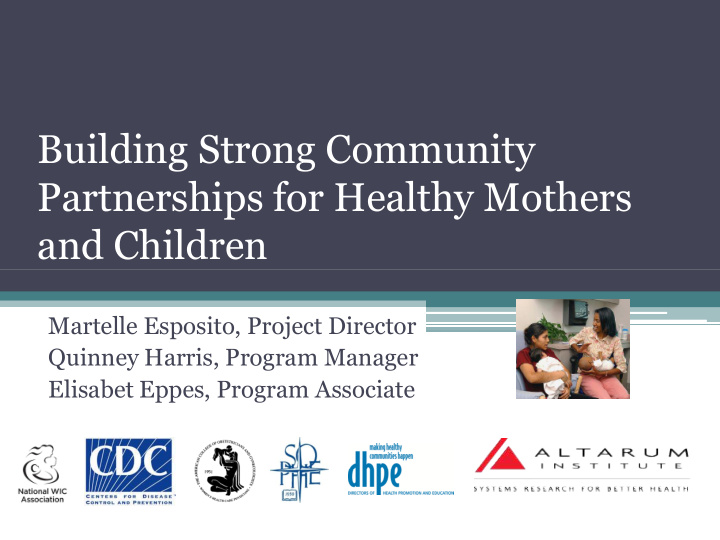



Building Strong Community Partnerships for Healthy Mothers and Children Martelle Esposito, Project Director Quinney Harris, Program Manager Elisabet Eppes, Program Associate
Background • This project is part of a large CDC grant, called National Implementation and Dissemination for Chronic Disease Prevention ▫ This 3-year cooperative agreement supports national organizations and ▫ This 3-year cooperative agreement supports national organizations and their members in building/strengthening community infrastructure to implement population-based strategies to improve communities’ health. • The National Organization Awardees include: ▫ National WIC Association (NWA) Community Capacity ▫ American Planning Association (APA) Building and Implementation ▫ American Heart Association (AHA) ▫ Society for Public Health Education (SOPHE) Disseminati on and ▫ Directors of Health Promotion and Education (DHPE) Training
Purpose of the Project • To create and implement community-driven plans to reduce chronic disease through policy, systems, and environmental (PSE) strategies. Risk Factors: Target population: 1. Poor nutrition Mothers and children 2. Lack of access to chronic disease prevention, risk reduction, and management opportunities
Who is Directly Involved in the Community Partnerships for Healthy Mothers and Children (CPHMC) Project? • Centers for Disease Control and Prevention (CDC) • National WIC Association (NWA) • American College of Obstetricians and Gynecologists (ACOG) (ACOG) • Altarum Institute • Society for Public Health Education (SOPHE) • Directors of Health Promotion and Education (DHPE) • 17 local WIC agencies in 10 target states
Our Approach is Based on the Social- Ecological Model Our PSE These high-level interventions will, strategies/interventions will in turn, impact community members focus on the Societal and at the Individual and Community levels Relationship levels.
CPHMC Project Context • Leveraging WIC strengths in a larger public health context ▫ Consider the external and home environment home environment ▫ Programming based on the identified needs of the target population ▫ Community partnerships ▫ Consistent messaging with other stakeholders ▫ Evaluation
Determinants of Health • Determinants of health – the range of personal, social, economic, and environmental factors that influence health status influence health status • Broad Categories: ▫ Policymaking ▫ Social factors ▫ Health services ▫ Individual behavior ▫ Biology and genetics
The Tip of the Iceberg
Policy, Systems and Environmental Change • Policy interventions may be a law, ordinance, resolution, mandate, regulation, or rule (both formal and informal) • Systems interventions are changes that impact all elements of an organization, institution, or system. • Environmental interventions involve physical or material changes to the economic, social, or physical environment.
Leveraging WIC Expertise • Local WIC agencies are unique and well-positioned to lead this work ▫ Expertise in public health nutrition ▫ Anchored in the community ▫ Anchored in the community ▫ Preexisting relationship with low- income mothers and children ▫ Framework in place for PSE interventions Referral system Adjunctive eligibility Relationship with clinicians, health agencies, and food retailers Food access projects Grant management experience
Recommend
More recommend